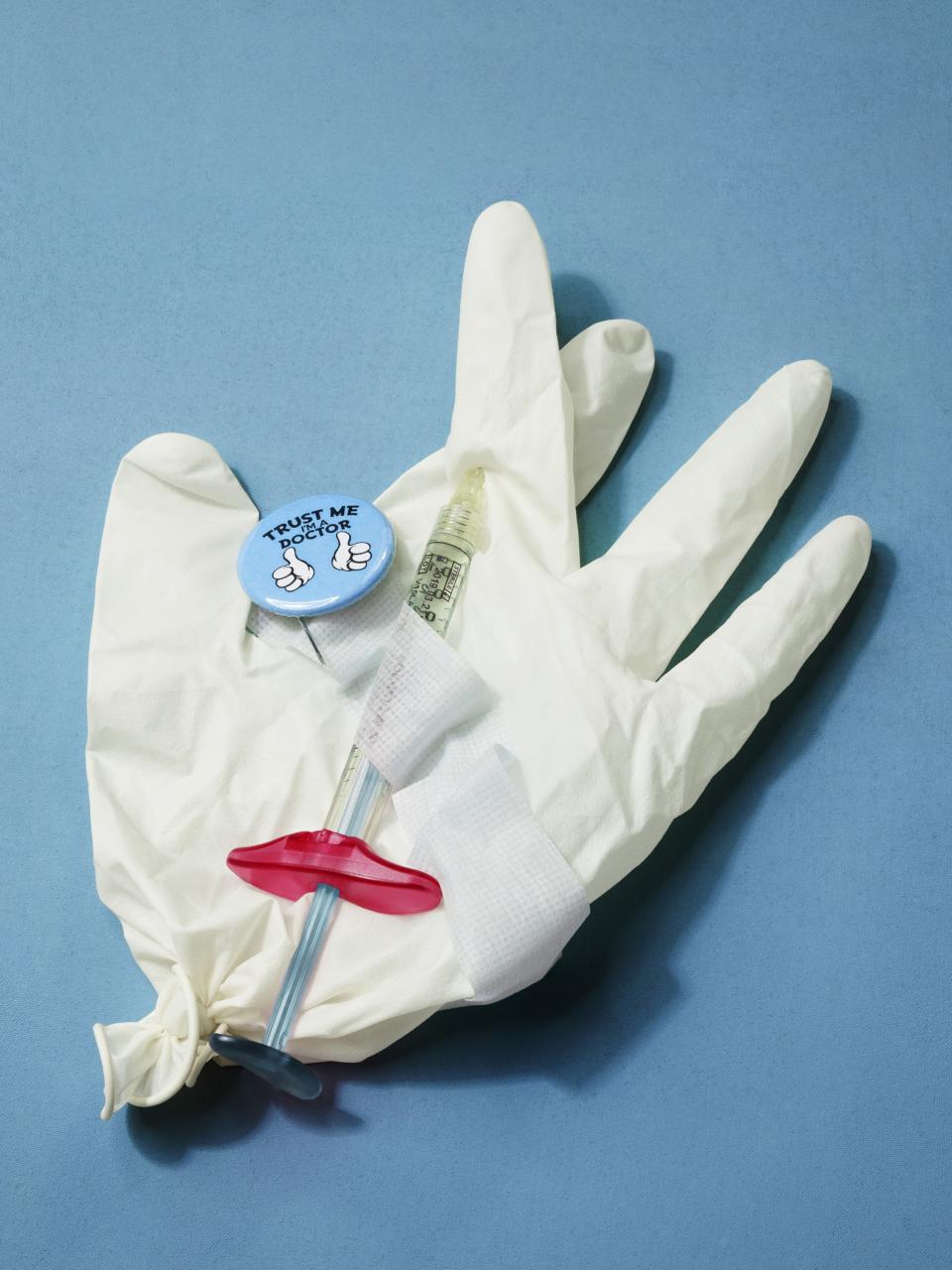Botox & Lip Injection Horror Stories That Prove You Should Always See a Board-Certified Dermatologist
We use them to freeze our wrinkles, plump up our lips, and sculpt our cheekbones. But that all comes with one very important asterisk: Botox and lip injections are only as good as the person holding the syringe.
“You’d be amazed how many times I have to sneak around husbands’ schedules,” says Sal Nadkarni. “I’m all about discretion.” Nadkarni, a cosmetic physician in Beverly Hills, isn’t being discreet for the reasons you might think. It’s because he makes house calls to administer Botox and fillers to housewives, reality-TV stars, and celebrities. The thing is, a cosmetic physician isn’t necessarily a dermatologist. Nadkarni is a primary-care physician. And he doesn’t administer injectables in a doctor’s office. In fact, he doesn’t have an office. “Cosmetic physician isn’t a residency training program, so you can’t know how much training a physician has,” he admits. “I’ve injected Botox thousands of times and am familiar with the musculature of the face, but a lot of shady stuff happens in the injectables industry. It’s a cash-paying business, and a lot of people want in.”
Welcome to 2018. The year in which your barista is asking you if you’d like some Restylane with your macchiato. Hyperbole? OK, yes. But you can find it at hotels, country clubs, tattoo parlors, and your living room. In places like Miami, there are parties at country clubs and hotels — often, charity fund-raisers or launch parties — where Botox is handed out like blinis. And in Venice, California, “I’ve passed by a place with a sign that says, ‘Tattoos! Toe rings! Botox!” says Jessica Wu, a dermatologist in Los Angeles, adding, “I hope the same person doesn’t do all three.” But if there’s one thing that’s weirder than getting a toe ring followed by an injectable, it’s getting a Pap smear followed by an injectable. Gynecologists around the country do cosmetic injections. And dentists, too — in case you want the total smile package: whiter teeth, fuller lips, no more laugh lines. In Las Vegas, you don’t even need to trouble your dentist — Nevada became the first state where dental hygienists can administer any facial injectable. It may not be the last.
When so many people want to shove stuff into your lips or crow’s-feet, it’s time to acknowledge that we are in the Wild West. You’d think the people doing the injecting have to have...a board certification? A medical license? A Pinkberry punch card? Nah. While you need a medical license to buy Botox or Dysport, Restylane or Juvéderm, you don’t necessarily need one to actually inject them into a fellow human. It’s a loophole that means nonphysicians are freezing foreheads at med-spas and walk-in Botox bars. You might see a picture of the “managing doctor” on the wall, but they could be five miles or five states away, depending on local laws.

While demand for these procedures has skyrocketed (about 7 million Botox or Botox-like procedures were performed in 2016, according to the American Society of Plastic Surgeons) and the med-spa industry is mushrooming (it’s worth $3.97 billion), states are not clear about how much legal oversight is needed, according to Sejal Shah, a dermatologist in New York City. All of these injectables — that is, the proliferation of them — kind of came out of nowhere and took off faster than states could figure out how to regulate them. So now your hair salon might ask you to decide between bangs or Botox. According to one expert, an injector might tell you she’s a doctor of nursing. “It’s vague and confusing, so you think they’re a physician when they’re not. You have no clue who you’re seeing,” says Shah. There’s proposed legislation in the House of Representatives — the Truth in Healthcare Marketing Act — that would, in part, regulate the way injectors can market themselves. But for now, there’s no consistent oversight.
So you wind up with scenarios like this: A patient calls their doctor, asking for a prescription for side effects (like cold sore flare-ups) from lip injections. “If you’re going to a provider who isn’t willing or able to deal with the potential complications of a cosmetic treatment, that’s a red flag,” says Shah. If the person giving you an injection can’t prescribe a drug for side effects, how is she getting the injectable in the first place? The most likely answer: the black market. “I get faxes for ‘discounted Turkish Botox’ all the time — what is that?” says Wu. Hard to say, but we can tell you what it’s almost definitely not: Botox. The same kind of thing happens with filler: “A woman came in with her upper lip three times as large as her lower lip,” says Wu. She’d been injected by a friend who’d just finished nursing school. “They both thought it was Juvéderm, but the patient handed me the box the filler came in, and it was in Greek. Literally, Greek! It’s cheaper to buy injectables made in other countries, so people do.”
And what happens next can be terrifying. “A woman came to me with her upper lip indented and hanging weirdly,” says Doris Day, a dermatologist in New York City. “She thought she’d bought lip filler, but it was silicone — and silicone is permanent.” There are a growing number of dermatologists who hesitate to treat patients who have gotten injectables of unspecified origin, says Boston dermatologist Ranella Hirsch, who does treat these patients. “It’s impossible to know what they’ve been injected with, so how can you treat it?” she says. You can’t always get medical records from med-spas, let alone that guy doing filler behind a curtain in a salon.
At least a dentist is a doctor, but whether or not that qualifies them to smooth your crow’s-feet or inflate your lips is debatable. State dental boards are currently trying to navigate this new gray area: Some let dentists do Botox for cosmetic purposes (plumping lips, hiding gummy smiles with Botox in the Cupid’s bow), while others don’t. “Without better regulations...patients should be savvy,” says Vasiliki Karlis, an associate professor of oral and maxillofacial surgery at New York University. “They should ask questions [about the injector’s educational background and licensure, years of experience and specific training] before allowing anyone to treat them.” That experience level could be years, or it could be one weekend (the American Academy of Facial Esthetics offers weekend-long courses on Botox and fillers).
Same goes for nonphysicians — a lot of them learn to inject in a weekend-long session that’s not even necessarily taught by a doctor. Also: It’s one weekend. When have you ever mastered anything in one weekend? “I’ve been doing injectables for years, and I’m still learning more and getting better at it,” says Day. “There’s no way you can understand complicated facial musculature after one weekend. So you could hit a blood vessel, cause blindness, or inject too much — that’s when people start to look like they’ve been blown up like balloons.” To put a fine point on it, “patients should get injectables from a board-certified dermatologist who is a member of the American Society for Dermatologic Surgery,” says Day. “These are highly skilled dermatologists and injectors.” You can confirm the board certification of any doctor with the American Board of Medical Specialties at abms.org.
When so many people are so blasé about needles and fillers, it feels like we took a wrong turn somewhere. “After awards shows, it’s all about who’s had Botox. It’s so common that it seems like it should be on every corner,” says Hirsch. “But it’s a medical procedure. And more so, a medical procedure for your face. No one believes that as much as the person who’s had it go wrong.”
A version of this article originally appeared in the April 2018 issue of Allure. To get your copy, head to newsstands or subscribe now.
More on injectables:
I Got Lip Fillers for the First Time and This Is What Happened
Experts Predict What the Future of Fillers, Lasers, and Injectables Will Look Like
Dr. Ava Shamban Explains Lip Injections


